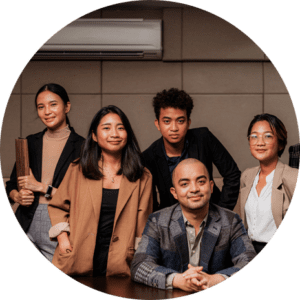Beyond Quotas:
Achieving True Diversity and Inclusion through Thoughtful Hiring Practices

EXECUTIVE SUMMARY
If you’re looking for an in-depth exploration of diversity and inclusion in the workplace, this whitepaper is your one-stop-shop. In it, we shed light on the importance of thoughtful hiring practices and inclusive cultures in nurturing and promoting true and authentic diversity.
We delve into the limitations of quota-based approaches and tick box exercises, as opposed to more holistic strategies that truly value individuals’ unique contributions and create environments where everyone feels valued and empowered.
Authentic diversity and inclusion are about far more than just representation; they involve creating a culture where all members of your organisation, regardless of their backgrounds, feel respected, valued, and able to contribute fully. The benefits of such an environment are manifold and include increased innovation, improved decision-making, enhanced employee satisfaction, and a stronger, more positive company reputation.
While quotas can be a starting point for increasing representation, they’re not a long-term or sustainable solution for achieving true diversity and inclusion. Quota-based approaches can lead to tokenism, and they don’t necessarily change underlying biases or discrimination. Instead, it’s important to focus on implementing thoughtful hiring practices and creating an inclusive culture that values every individual’s unique contributions.
In this whitepaper, we advocate for a shift away from quota-based approaches and towards more comprehensive strategies that promote genuine diversity and inclusion. By doing so, you can create a workplace where all individuals feel valued and empowered to contribute. And reap the many benefits that diversity and inclusion bring.
“CREATING A CULTURE WHERE ALL MEMBERS OF YOUR ORGANISATION, REGARDLESS OF THEIR BACKGROUNDS, FEEL RESPECTED, VALUED, AND ABLE TO CONTRIBUTE FULLY”
In our increasingly globalised world, diversity and inclusion have become essential in the workplace. They’re no longer just buzzwords, but integral components of productive and successful business models. But achieving true diversity and inclusion extends far beyond quotas and requires thoughtful hiring practices. And it’s this concept we’ll explore in more depth.
What is Diversity and Inclusion?
Diversity refers to the presence of a wide range of distinct identities, experiences, and perspectives in a group or organisation. It encompasses various dimensions, including but not limited to race, gender, age, sexual orientation, religion, disability, and socioeconomic status.
On the other hand, inclusion, is the practice of ensuring that individuals from these diverse backgrounds feel valued, respected, and supported. It’s about creating an environment where everyone has an equal opportunity to contribute, thrive and achieve their potential.
Yet did you know that despite the widespread recognition of the importance of diversity and inclusion, many workplaces are still falling short? According to a 2023 report by McKinsey & Company in partnership with LeanIn.Org., women, particularly women of colour, remain underrepresented at every level in corporate America. And that’s despite business’ increased efforts to promote diversity and inclusion. The positive statistics are that since 2015, the number of women in the C-suite has “increased from 17 to 28 percent.” But there’s still a long way to go.
Similarly, individuals from other marginalised groups often face barriers to entry and progression. This situation highlights the need for more effective strategies to maximise diversity and inclusion.
The Role of Quotas in Diversity Initiatives
Quotas have traditionally been used as a tool to increase diversity in the workplace. They involve setting specific targets for the recruitment or promotion of individuals from underrepresented groups. And while quotas can be effective in increasing diversity statistically, they often fail to address the underlying biases and systemic issues that hinder true inclusivity. In short, they can lead to tokenism – where individuals are hired or promoted primarily to meet diversity targets rather than based on their skills and qualifications. So, while quotas have a role to play, they’re not the be-all and end-all of diversity initiatives.
That’s where thoughtful hiring practices come into play. In this whitepaper, we’ll delve deeper into how organisations like yours can go beyond quotas to achieve true diversity and inclusion through thoughtful hiring practices.
SUPERFICIAL DIVERSITY VS. INCLUSIVE DIVERSITY
The pitfalls of quota-based approaches
As we’ve pointed out, quota-based approaches, while normally well-intentioned, often lead to superficial diversity rather than a truly inclusive culture. By superficial diversity we mean the presence of individuals from under represented groups within a business, without a corresponding shift in the organisation’s values, behaviours, and processes to support and include those individuals.
The risk here is that companies can become complacent. Once they’ve achieved their quota, it’s easy for the ongoing work required to build a culture that respects and values difference, to be neglected. And this can lead to a “tick box” mentality where diversity is viewed as a requirement to be fulfilled rather than a value to be embraced. This approach to diversity and inclusion can then inadvertently reinforce stereotypes by suggesting that individuals from certain groups need special assistance to succeed. And can fuel perceptions of unfairness and bias and discriminatory hiring practices, undermining the very equality that diversity initiatives aim to promote.


Resistance and backlash
Quota-based approaches can also lead to resistance and backlash. Employees may perceive quotas as reverse discrimination, leading to resentment and conflict.
There can be a backlash from those who feel that they are being overlooked in favour of less qualified candidates from underrepresented groups. And another issue is that quotas can create a perception that diversity is being prioritised over merit, leading some individuals to question the capabilities and qualifications of diverse hires.
This can damage team cohesion and create a hostile work environment for individuals from underrepresented groups. But achieving true diversity and inclusion requires going beyond quotas and adopting more thoughtful and holistic approaches.
A better solution? Building an authentically inclusive culture.
In contrast to meeting quotas, this approach involves far more than numerical representation. It requires creating an environment where all individuals feel valued, heard, and empowered to contribute. It involves challenging biases, dismantling systemic barriers, and making room for diverse voices at every level of a business. It’s about implementing thoughtful hiring practices.
THE NEED FOR THOUGHTFUL HIRING PRACTICES
Shifting Focus to Quality of Hires
Yes, diversity’s a crucial aspect of modern workplaces, but it’s also important to remember it shouldn’t overshadow the significance of hiring quality employees. A shift in focus from merely filling quotas to hiring high-quality, diverse candidates is the key to hiring more sustainable and beneficial outcomes.
Quality hires bring a wealth of skills, experiences and perspectives that can enhance team performance, encourage innovation, and drive business growth. By focusing on the quality of hires, you can ensure you’re bringing in individuals who can contribute meaningfully to their team and broader organisational goals.
This shift requires moving away from traditional hiring practices that may inadvertently favour certain groups. Instead, it’s about striving for objective, competency-based assessments that evaluate candidates on their potential to perform in the role and contribute to your business.
Building a Diverse Talent Pipeline
A key component of thoughtful hiring practices involves proactively building a diverse talent pipeline. This entails actively seeking out talented individuals from a wide range of backgrounds and experiences.
If you’re looking build a diverse talent pipeline, start by establishing partnerships with universities, professional organisations, and communities that cater to diverse groups. Consider using online platforms and social media to reach a wider pool of potential candidates too.
And what about implementing internship and mentorship programs aimed at nurturing diverse talent? These initiatives can provide valuable opportunities for underrepresented individuals to gain industry experience, develop professional skills, and establish networks, improving their employability and prospects for career advancement.
“BY FOCUSING ON THE QUALITY OF HIRES, YOU CAN ENSURE YOU’RE BRINGING IN INDIVIDUALS WHO CAN CONTRIBUTE MEANINGFULLY TO THEIR TEAM AND BROADER ORGANISATIONAL GOALS”
Aligning Hiring Practices with Organisational Values
Remember, thoughtful hiring practices should align with your business values. This means creating a hiring process that’s transparent, fair, and inclusive.
Hiring managers should be trained to recognise and mitigate unconscious biases that may influence their decision-making. And organisations should also implement structured interviews and use objective assessment tools to ensure a fair and unbiased evaluation of candidates.
Your company’s commitment to diversity and inclusion should be clearly communicated in your job postings, recruitment materials, and interactions with potential candidates. This can help attract individuals who share your values and are committed to being part of, and contributing, to a diverse and inclusive workplace.
To implement thoughtful hiring practices, you need a strategic and holistic approach. By adopting these kinds of practices, you can create a workforce that’s not only diverse but also highly skilled, engaged, and aligned with your mission and values.
COMPONENTS OF THOUGHTFUL HIRING PRACTICES
What makes up a thoughtful hiring practice? Here are some of the key components.
1. Inclusive Job Descriptions and Requirements
Inclusive job descriptions are a key component of thoughtful hiring practices. They should be free from gendered language and shouldn’t list unnecessary requirements that may deter candidates. It’s crucial to focus on the skills and competencies needed for the role – not just previous experience or qualifications.
Inclusive job descriptions should also clearly state your organisation’s commitment to diversity and inclusion. This can signal to potential candidates that your business values diverse backgrounds and perspectives, and you’ll likely attract a broader pool of applicants.
2. Unbiased Recruitment and Selection Process
An unbiased recruitment and selection process is another critical aspect of thoughtful hiring practices. This involves using objective criteria to assess candidates, as well as concerted efforts to mitigate unconscious biases.
Think about implementing structured interviews – where all candidates are asked the same set of questions and evaluated based on pre-determined criteria. Using data-driven assessment tools can also help reduce bias by ensuring that decisions are based on quantifiable evidence rather than subjective impressions.
3. Implementing Blind Auditions
Blind auditions – where identifying information is removed from job applications – can help reduce bias in hiring. By evaluating candidates based on their skills and competencies alone, you can ensure a fair and equitable selection process.
This is a technique that’s been shown to be effective in various fields. For instance, did you know that orchestras started using blind auditions in the 1970s, which significantly increased the proportion of female musicians?
4. Structured Interviewing Techniques
Structured interviewing techniques involve asking all candidates the same set of questions in the same order and then scoring their responses based on pre-determined criteria. This can ensure consistency and fairness in the interview process.
Additionally, structured interviews can help reduce bias because they focus on the candidate’s skills and competencies rather than irrelevant factors such as appearance or personality traits. Research has shown that structured interviews are more predictive of job performance than unstructured ones.
If you’re looking to create a fair and equitable hiring process that attracts and selects high-quality, diverse candidates, adapting these practices is essential.
DEVELOPING A CULTURE OF INCLUSION
A culture of inclusion must be ‘developed’ – it doesn’t happen overnight. It requires a holistic approach and continuous awareness and commitment. In this section we’ll explore some of the ways you can work towards creating an inclusive working environment.
Training and Education for Hiring Teams
Developing a culture of inclusion begins with equipping hiring teams with the necessary training and education. This includes understanding the value of diversity, recognising unconscious biases, and learning how to conduct fair and equitable interviews. Training should also cover inclusive language and practices to ensure that all candidates feel welcomed and respected.
Leadership Commitment to Diversity
Leadership commitment is crucial in encouraging an inclusive culture. Leaders set the tone for your entire organisation, and their attitudes towards diversity and inclusion can significantly influence the behaviours and attitudes of employees.
Leaders should demonstrate their commitment to diversity through their actions, such as holding themselves accountable for diversity goals, advocating for inclusive policies, and promoting diverse individuals into leadership roles. They can also lead by example by engaging in diversity training and education programs.
Employee Resource Groups and Mentorship Programs
Employee Resource Groups (ERGs) and mentorship programs can also play a key role in developing a culture of inclusion. ERGs provide a platform for employees from underrepresented groups to connect, support each other, and advocate for change. They can also provide valuable insights your business about the challenges and needs of diverse employees.
Mentorship programs, on the other hand, can help diverse employees navigate challenges, develop professional skills, and advance their careers. By pairing diverse employees with experienced mentors, businesses can create a more inclusive culture and enhance the career prospects of underrepresented individuals.
Encouraging an Inclusive Workplace Culture
An inclusive workplace culture is one where all individuals feel valued, heard, and empowered to contribute. This involves creating safe spaces for employees, being open to different perspectives, and actively seeking out and valuing diversity.
But on a higher level, an inclusive culture requires ongoing efforts to challenge biases, dismantle systemic barriers, and make room for diverse voices at every level of the company. This can involve implementing inclusive recruitment strategies, soliciting employee feedback, and hosting social events that celebrate diversity.
MEASURE SUCCESS AND ACCOUNTABILITY
To continuously improve your diversity and inclusion efforts, it’s essential to measure and monitor your progress. Here are our top tips for keeping track of your success.
Key Performance Indicators for Diversity and Inclusion
Key Performance Indicators (KPIs) are crucial for measuring the success of diversity and inclusion efforts. These might include metrics such as the percentage of diverse hires, the proportion of diverse employees in leadership roles, or the retention rates of diverse employees.
Other KPIs could be tied to employee engagement and satisfaction. Surveys can be used to assess whether all employees feel valued and included, and whether they believe your business is committed to diversity and inclusion.


Regular Audits and Assesments
Regular audits and assessments are another important component of measuring success and ensuring accountability. These should evaluate not only the diversity of your workforce but also the inclusivity of your workplace culture.
Audits can identify potential biases in recruitment, hiring, and promotion processes, as well as uncover systemic barriers to diversity and inclusion3. On the other hand, assessments can provide insights into employees’ perceptions of the workplace culture and identify areas for improvement.
Transparency and Communication
Transparency and communication are key to holding organisations accountable for their diversity and inclusion commitments. This involves regularly sharing updates about your company’s progress towards its diversity and inclusion goals, as well as any challenges encountered along the way.
It’s therefore important that you encourage open dialogue about diversity and inclusion. This can involve hosting meetings, creating feedback channels, or establishing diversity and inclusion committees. By creating an environment where employees feel comfortable discussing these issues, you can ensure that all voices are heard and that diversity and inclusion remain a priority.

OVERCOMING CHALLENGES
Like many things, achieving diversity and inclusion through throughtful hiring practices does present some challenges. Here’s what to be prepared for.
Addressing Bias and Discrimination
Bias and discrimination remain significant hurdles in achieving true diversity and inclusion. To address these issues, it’s important to first acknowledge their existence and impact.
Training programs can help raise awareness about unconscious biases and provide strategies for overcoming them. Additionally, implementing fair and equitable hiring practices, such as blind recruitment or structured interviews, can help reduce bias in the recruitment process.
Organisations should also establish clear policies against discrimination and ensure that all employees understand these policies. This includes providing mechanisms for reporting and addressing incidents of discrimination.
Navigating Organisational Resistance
Resistance to change is a common challenge in diversity and inclusion efforts. This resistance can stem from a lack of understanding about the benefits of diversity, fear of change, or entrenched biases and prejudices.
To navigate this resistance, you should aim to engage in open dialogues about diversity and inclusion, provide education and training, and demonstrate the business case for diversity. Leaders play a crucial role in this process by setting the tone for the business and demonstrating their commitment to diversity and inclusion.
“THE RESISTANCE CAN STEM FROM A LACK OF UNDERSTANING ABOUT THE BENEFITS OF DIVERSITY, FEAR OF CHANGE, OR ENTRENCHED BIASES AND PREJUDICES”
Continuous Improvement Strategies
Diversity and inclusion are not one-time initiatives but ongoing efforts that require continuous improvement. With that in mind, it’s crucial to regularly evaluate your diversity and inclusion strategies and make adjustments as needed.
This involves collecting and analysing data on diversity and inclusion metrics, soliciting feedback from employees, and staying informed about best practices in the field.
Also, be open to trying new strategies and willing to learn from your mistakes.
CONCLUSION
True diversity and inclusion go beyond mere representation. It involves creating an environment where all individuals, regardless of their background, feel valued, respected, and empowered to contribute. This not only benefits the individuals but also your company as a whole. Diverse and inclusive workplaces encourage innovation, creativity, and better decision-making. And they attract and retain top talent, improve employee engagement and satisfaction, and enhance your reputation.
Thoughtful hiring practices play a crucial role in promoting diversity and inclusion. By ensuring that the recruitment process is fair, equitable, and inclusive, you can attract a diverse pool of candidates and reduce bias in hiring decisions. This includes implementing strategies such as balanced teams, blind recruitment, and structured interviews.
But thoughtful hiring practices are just the start. The end goal is creating an inclusive workplace culture where all employees feel valued and included. This involves implementing diversity and inclusion training, promoting open dialogue about diversity and inclusion, setting clear diversity and inclusion goals, and holding accountablity for these commitments.
True diversity and inclusion are not only possible but essential for your ongoing success. Only by implementing thoughtful hiring practices and developing an inclusive workplace culture, will you reap the many benefits of diversity and inclusion.
If you’re serious about creating a diverse and inclusive workplace through thoughtful hiring practices, why not speak to one of our talented consultants? We’re working with businesses like yours daily to help them implement first-class hiring processes that help them to meet their short and long-term diversity and inclusion goals…and reap the many rewards of building a truly diverse and inclusive organisation.
